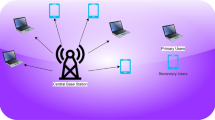Abstract
Mobile ad hoc networks (MANETs) are dynamically configurable wireless networks that have no fixed infrastructures and do not require predefined configurations. In MANETs, the high mobility of mobile nodes is a major cause of link failure. This paper proposes a reward-based routing protocol (RBRP) for MANETs. The proposed protocol uses the Q-learning route strategy to select a stable route to enhance system performance. The reward of a route is decided by four factors: hop count, bandwidth, power of battery, and speed of mobile nodes. Route discovery usually first finds multiple routes from the source node to the destination node. Then, the path with the greatest reward value for routing is selected. This study also compares the performance of the RBRP protocol with the well-known ad hoc on-demand distance vector (AODV) protocol. Simulation results show that the proposed RBRP outperforms the AODV protocol, especially in a high-mobility environment.











Similar content being viewed by others
References
Seno, S. A. H., Budiarto, R., & Wan, T. (2011). A routing layer-based hierarchical service advertisement and discovery for MANETs. Ad Hoc Networks, 9, 355–367.
Garg, N., Aswal, K., & Dobhal, D. C. (2012). A review of routing protocols in mobile ad hoc networks. International Journal of Information Technology, 5, 177–180.
Raich, A., & Vidhate, A. (2013). Best path finding using location aware AODV for MANET. International Journal of Advanced Computer Research, 3, 336–340.
EL-Afandi, H. (2006). An intelligent wireless ad hoc routing protocol. Milwaukee, WI, USA: University of Wisconsin-Milwaukee.
Misra, P. (2000). Routing protocols for ad hoc mobile wireless networks. http://www.cis.ohio-state.edu/~misra
Wang, N.-C., Huang, Y.-F., & Chen, J.-C. (2007). A stable weight-based on-demand routing protocol for mobile ad hoc networks: an International Journal. Information Sciences, 177, 5522–5537.
Stojmenovic, I. (2002). Position-based routing in ad hoc networks. IEEE Communications Magazine, 40, 128–134.
You, L., Li, J., Wei, C., Dai, C., Xu, J., & Hu, L. (2014). A hop count based heuristic routing protocol for mobile delay tolerant networks. The Scientific World Journal, 2014, 603547
Kanakaris, V., Ndzi, D., & Azzi, D. (2010). Ad hoc networks energy consumption: A review of the ad-hoc routing protocols. Journal of Engineering Science and Technology Review, 3, 162–167.
Vu, T. K., & Kwon, S. (2014). Mobility-assisted on-demand routing algorithm for MANETs in the presence of location errors. The Scientific World Journal, 2014, 790103.
Sivakumar, B., Bhalaji, N., & Sivakumar, D. (2014). A survey on investigating the need for intelligent power-aware load balanced routing protocols for handling critical links in MANETs. The Scientific World Journal, 2014, 603547.
Xia, H., Jia, Z., Li, X., Ju, L., & Sha, E. H. M. (2013). Trust prediction and trust-based source routing in mobile ad hoc networks. Science Direct Ad Hoc Networks, 11, 2096–2114.
Moussaoui, A., Semchedine, F., & Boukerram, A. (2014). A link-state QoS routing protocol based on link stability for mobile ad hoc networks. Journal of Network and Computer Applications, 39, 117–125.
Kumar, K., & Singh, V. P. (2014). Power consumption based simulation model for mobile ad-hoc network. Wireless Personal Communications, 77, 1437–1448.
Kumar Jain, Y., & Kumar Verma, R. (2012). Energy level accuracy and life time increased in mobile ad-hoc networks using OLSR. International Journal of Advanced Research in Computer Science and Software Engineering, 2, 97–103.
Watkins, C. (1989). Learning from delayed rewards. PhD Thesis, King’s College, England: Cambridge.
Meta, E., Miedzowicz, E. D., Román, A., Gutnisky, D., & Zanutto, B. S. (2004). Reward-based routing and braess’ paradox an efficient resource usage strategy. Global Telecommunications Conference, IEEE Communications Society, 3, 1436–1440.
Sutton, R., & Barto, G. A. (1998). Reinforcement learning: An introduction. Cambridge, MA, USA: Cambridge MIT Press.
Kaelbling, L. P., Littman, M. L., & Moore, A. W. (1996). Reinforcement learning: A survey. Journal of Artificial Intelligence Research, 4, 237–285.
Tseng, Y.-C., Li, Y.-F., & Chang, Y.-C. (2003). On route lifetime in multihop mobile ad hoc networks. IEEE Transactions on Mobile Computing, 2, 366–376.
Tabatabaei, S., & Tabatabaei, K. (2010). Routing and quality of service support for mobile ad hoc networks. In 2nd International Conference on Computer Engineering and Technology.
Badis, H. et al. (2003). QoS for ad hoc networking based on multiple metrics: Bandwidth and delay. MWCN’03.
OPNET modeler. http://www.opnet.com
Broch, J., Maltz, D. A., Johnson, D. B., Hu, Y., & Jetcheva, J. (1998). A performance comparison of multi-hop wireless ad hoc network routing protocols. In International Conference on Mobile Computing and Networking, 85–97, New York.
Michiardi, P., & Molva, R. (2002). Simulation-based analysis of security exposures in mobile ad hoc networks. In Proceedings of European Wireless Conference.
Wang, N.-C., Huang, Y.-F., & Chen, J.-C. (2007). A stable weight-based on-demand routing protocol for mobile ad hoc networks. Information Sciences, 177, 5522–5537.
Author information
Authors and Affiliations
Corresponding author
Rights and permissions
About this article
Cite this article
Tabatabaei, S., Teshnehlab, M. & Mirabedini, S.J. A New Routing Protocol to Increase Throughput in Mobile Ad Hoc Networks. Wireless Pers Commun 83, 1765–1778 (2015). https://doi.org/10.1007/s11277-015-2475-2
Published:
Issue Date:
DOI: https://doi.org/10.1007/s11277-015-2475-2




